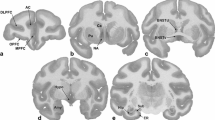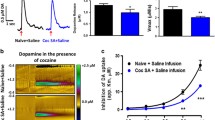Abstract
Daily, intermittent, subcutaneous cocaine injections produce sensitization, while the continuous administration of cocaine produces tolerance to the behavioral effects of subsequent cocaine injections. The present experiments examined whether these behavioral differences are related to differences in the ability of cocaine to increase extracellular dopamine. Increases in perfusate DA, in response to different concentrations of cocaine, were measured in caudate-putamen slices obtained from rats withdrawn for 7 days from a 14-day treatment of either continuous or daily subcutaneous cocaine injections. Compared to saline controls, cocaine-induced DA efflux was increased in subjects receiving daily injections and markedly decreased in subjects receiving continuous cocaine. Thus, different temporal patterns of cocaine administration produce dramatically different alterations in DA neurotransmission. Such changes in dopamine release may be related to the withdrawal symptoms experienced by human cocaine abusers.
Similar content being viewed by others
References
Akimoto K, Hammamura T, Otsuki S (1989) Subchronic cocaine treatment enhances cocaine-induced dopamine efflux studied by in vivo intracerebral dialysis. Brain Res 490:339–344
Castaneda E, Becker JB, Robinson TW (1988) The long-term effects of repeated amphetamine treatment in vivo on amphetamine, KCL and electrical stimulation evoked striatal dopamine release in vitro. Life Sci 42:2447–2456
Ettenberg A, Pettit HO, Bloom FW, Koob GR (1982) Heroin and cocaine intravenous self-administration in rats: mediation by separate neural systems. Psychopharmacology 78:204–209
Falk JL, Fang M, Lau CE (1991) Chronic oral cocaine self-administration: pharmacokinetics and effects on spontaneous and discriminative motor functions. J Pharmacol Exp Ther 257:457–465
Gawin FH, Ellinwood EH Jr (1988) Cocaine and other stimulants: actions, abuse and treatments. N Eng J Med 318:1173–1182
Ho BT, Taylor DL, Esteves VS, Englert LF, McKenna ML (1977) Behavioral effects of cocaine—metabolic and neurochemical approach. In: Ellinwood EH, Kilbey MM (eds) Advances in behavioral biology: cocaine and other stimulants. Plenum Press, New York, pp 229–240
Izenwasser S, Cox BM (1992) Inhibition of dopamine uptake by cocaine and nicotine: Tolerance to chronic treatments. Brain Res 573:119–125
Johanson CE, Fischman MW (1989) The pharmacology of cocaine related to its abuse. Pharmacol Rev 41:3–52
Joyner C, King G, Lee TH, Ellinwood EH Jr (1992) A technique for the continuous infusion of high doses of cocaine by osmotic minipump. Pharmacol Biochem Behav (in press)
Kalivas PW, Duffy P (1988) Effects of daily cocaine and morphine treatment on somatodendritic and terminal field DA release. J Neurochem 50:1498–1504
Kalivas PW, Duffy P (1990) Effect of acute and daily cocaine treatment on extracellular dopamine in the nucleus accumbens. Synapse 5:48–58
Kalivas PW, Duffy P, Dumars LA, Skinner C (1988) Behavioral and neurochemical effects of acute and daily cocaine administration in rats. J Pharmacol Exp Ther 245:485–492
Kilbey MM, Ellinwood EH Jr (1977) Administration of stimulant drugs: response modification. In: Ellinwood EH, Kilbey MM (eds) Advances in behavioral biology: cocaine and other stimulants. Plenum Press, New York, pp 409–429
King GR, Joyner C, Lee T, Kuhn C, Ellinwood EH Jr (1992 a) Intermittent and continuous cocaine administration: residual behavioral states during withdrawal. Pharmacol Biochem Behav 43:243–248
King GR, Joyner C, Lee TH, Ellinwood EH Jr (1992 b) Withdrawal from continuous or intermittent cocaine: effects of NAN-190 on cocaine-induced locomotion. Pharmacol Biochem Behav (in press)
Koob GF, Bloom FW (1988) Cellular and molecular mechanisms of drug dependence. Science 242:715–723
Kula NS, Baldessarini RJ (1991) Lack of increase in dopamine transporter binding or function in rat brain tissue after treatment with blockers of neuronal uptake of dopamine. Neuropharmacology 30:89–92
Lau CE, Imam A, Fang M, Falk JL (1991) Acute effects of cocaine on spontaneous and discriminative motor functions: relation to route of administration and pharmacokinetics. J Pharmacol Exp Ther 257:444–456
Ng JP, Hubert GW, Justice JB Jr (1991) Increased stimulated release and uptake of dopamine in nucleus accumbens after repeated cocaine administration as measured by in vivo voltammetry. J Neurochem 56:1485–1492
Nicolaysen LC, Hwai-Tzong P, Justice JB Jr (1988) Extracellular cocaine and dopamine concentrations are linearly related in rat striatum. Brain Res 456:317–323
Peris J, Boyson SJ, Cass W, Curella P, Dwoskin LP, Larson G, Lin L-H, Yasuda RP, Zahniser NR (1990) Persistency of neurochemical changes in dopamine systems after repeated cocaine administration. J Pharmacol Exp Ther 253:38–44
Pettit HO, Hwai-Tzong P, Parsons LH, Justice JB Jr (1990) Extracellular concentrations of cocaine and dopamine are enhanced during chronic cocaine administration. J Neurochem 55:798–804
Post RM (1977) Progressive changes in behavior and seizures following chronic cocaine administration: relationship to kindling and psychosis. In: Ellinwood EH, Kilbey MM (eds) Advances in behavioral biology: cocaine and other stimulants. Plenum Press, New York, pp 353–372
Post RM, Contel NR (1983) Human and animal studies of cocaine: implications for development of behavioral pathology. In: Creese I (ed) Stimulants: neurochemical, behavioral, and clinical perspectives. Raven Press, New York, pp 169–203
Reith MEA, Benuck M, Lajtha A (1987) Cocaine disposition in the brain after continuous or intermittment treatment and locomotor stimulation in mice. J Pharmacol Exp Ther 243:281–287
Stripling JS, Ellinwood EH Jr (1976) Cocaine: physiological and behavioral effects of acute and chronic administration. In: Mule SJ (ed) Cocaine: chemical, biological, clinical, social, and treatment aspects CRC Press, Cleveland, pp 167–185
Wise RA, Bozarth MA (1981) Brain substrates for reinforcement and drug self-administration. Prog Neuropsychopharmacol 5:467–474
Author information
Authors and Affiliations
Rights and permissions
About this article
Cite this article
King, G.R., Kuhn, C. & Ellinwood, E.H. Dopamine efflux during withdrawal from continuous or intermittent cocaine. Psychopharmacology 111, 179–184 (1993). https://doi.org/10.1007/BF02245520
Received:
Revised:
Issue Date:
DOI: https://doi.org/10.1007/BF02245520




